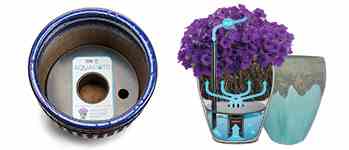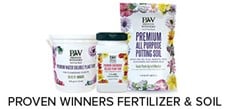Mulch Types: The Scoop on Garden Mulch
Mulch comes in different types with a variety of uses in the landscape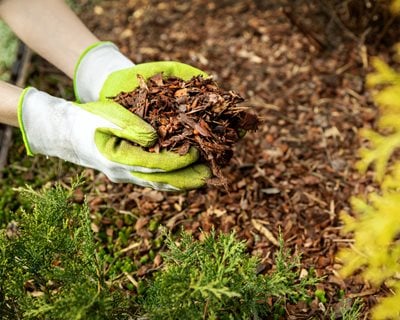
Photo by: ronstik / Shutterstock.
Anyone who has gardened has heard of mulch. But what exactly is mulch, and why is it important to your garden? This essential gardening supplement comes in different types with a variety of uses. Mulching materials used for a vegetable plot are different than those applied in a shrub border.
There are two primary types of mulch: organic and inorganic. By learning more about mulch and how to use it in your yard, you will be well on your way towards a more beautiful and healthy landscape.
Also see: How & When to Mulch Your Yard
WHAT IS MULCH?
Garden mulch is material that is laid on the surface of the soil. It can be comprised of organic materials such as compost, bark, manure, leaves, or grass clippings; or inorganic materials such as gravel, stone, fabric, or plastic.
THE BENEFITS OF MULCH
There are many benefits to using mulch. Primary benefits include:
- Suppresses weeds and inhibits germination by keeping light from weed seeds
- Reduces evaporation while retaining soil moisture, helping to reduce water usage
- Stems water runoff, helping to control erosion
- Insulates the root zone from extreme heat or cold
Other benefits include:
- Prevents plants from being pushed out of the ground during freeze/thaw cycles
- Organic mulch adds nutrients to the soil, improves drainage and soil structure, and reduces compaction
- Prevents a hard crust from forming on the top of the soil, allowing water and nutrients to penetrate into the soil
- Reduces damage and disease for crops such as melons, cucumbers and tomatoes by keeping fruits off the ground
- Lessens soil-borne diseases caused by water splashing onto foliage
- Many mulches are decorative, enhancing the appearance of the landscape
There are different kinds of mulch for different purposes. Here are some of the most commonly used garden mulches.
TYPES OF ORGANIC MULCH
Organic mulches are natural plant-based materials. Organic mulch enriches the soil as it breaks down to improve soil structure and nourish plants. Soil, bark, or manure-based mulches can be purchased in bags at local nurseries and garden centers. For larger quantities, there are companies that sell mulch in bulk.
Some organic mulches such as leaves and grass clippings are free and readily available in your own yard. You can also make your own compost for little or no expense. Obtain organic mulches from a reputable source to avoid introducing weed seeds, pathogens, or pesticides. Materials treated with chemical herbicides or pesticides should not be used on edible crops. Avoid dyed products, which contain chemicals that can leach into the soil.
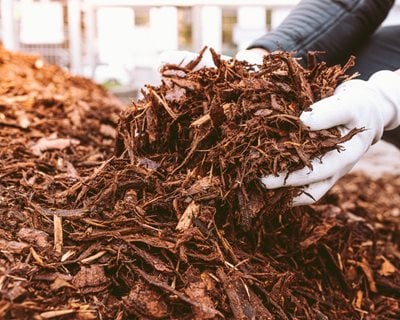
Photo by: Iarisa Stefanjuk / Shutterstock.
- Shredded bark is one of the most common mulches and is less expensive than other types. It is made from a variety of wood byproducts including bark that are shredded into fine pieces. Shredded bark is most often used in beds around trees and shrubs and is resilient to water runoff, making it useful along slopes and hillsides. This decorative mulch breaks down slowly to feed plants and may need replenishing every 1 to 2 years.
- Wood chips are made from branches, stumps and other wood waste that is ground into chunks. This mulch is coarser than shredded bark and comes in different sizes, with larger chunks taking longer to decompose. They are most often used in foundation and shrub borders as a longer-lasting alternative to shredded bark.
- Compost is made from a variety of green and brown organic materials that are blended and allowed to decompose. It adds nutrients to the soil, improving drainage and soil structure. Compost is most often mixed into native soil as an amendment, but can also be used as a top dressing in established beds. Different types of compost include all-purpose, mushroom, worm castings, leaf mold, or manure-based compost. Find out how to make your own compost.
- Manure is waste derived from cows, horses, chickens and rabbits. It is a rich source of nutrients, helping to improve soil structure and drainage. Manure is used as a soil amendment or to mulch garden beds and vegetable plots. The best sources of manure are finished bagged products from garden centers, or in bulk from soil companies. Fresh manure from farms may contain weed seeds and should be allowed to age before using.
- Grass clippings produced from mowing the lawn are a green material, rich in nitrogen. They can be mulched back into the lawn or laid on top of garden beds. Avoid using grass clippings around edible crops if your lawn has been treated with chemical pesticides or fertilizers.
- Leaves that drop in fall from deciduous trees and shrubs are a rich source of nutrients. They can be placed on top of garden beds to insulate plant roots over the winter, feeding the soil as they break down. Leaves can be shredded with a lawn mower so they decompose quicker and are less likely to mat, which can impede the flow of water and nutrients. Use leaf mulch or shredded leaves in flower beds, shrub borders and vegetable plots.
- Pine needles can be used as mulch around trees and shrubs, particularly acid loving plants such as azaleas, rhododendrons and blueberries. Even though pine needles are acidic, they don’t generally cause issues with soil pH. Pine needles are lightweight and fluffy, breaking down slowly to nourish plants.
- Straw is made from the stalks of grain crops such as wheat, oats and rye. Unlike hay, which is made of dried grass and used for animal feed, the seed heads of straw are removed to prevent seeding in garden beds. Straw is primarily used in vegetable gardens and strawberry beds for suppressing weeds and retaining moisture, while breaking down to nourish crops. It is sold in bales at farm supply stores and garden centers.
- Cardboard can be used for covering turf grass or weedy areas to transform them into garden beds. This method is known as sheet mulching. Cardboard is laid on the surface and covered with bark, compost or other organic material. The cardboard smothers grass and weeds and breaks down to contribute to soil tilth. Areas can be mulched with cardboard in fall and planted the following year.
- Cocoa bean shells are roasted hulls of cocoa beans and a byproduct of making chocolate. This decorative mulch is useful in garden beds for suppressing weeds, retaining moisture, and nourishing plants. Cocoa bean shells may be toxic to pets, particularly dogs. This mulch is more expensive than other types, so it can be used for smaller areas or containers.
- Hazelnut shells can be used in a similar manner to cocoa shells and come in an attractive color of rich chestnut brown.
- Sawdust from woodworking projects can be used similarly to other wood-based mulches.
- Ground cover plants can be used as a living mulch. They are a low maintenance alternative to traditional lawns and can be massed in difficult areas such as deep shade to suppress weeds and retain moisture. Some of the best ground covers for living mulch include ajuga, bishop’s hat, creeping thyme, lamb’s ears, lamium, liriope, mondo grass, pachysandra, and sweet woodruff. Find more eco-friendly lawn alternatives.
TYPES OF INORGANIC MULCH
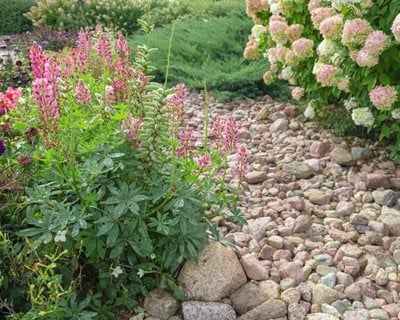
Photo by: Marina Demidiuk / Shutterstock.
Inorganic mulches are made of inert materials, are longer lasting and tend to be more expensive than organic mulch. Here are some of the most common types:
- Gravel and stone come in different sizes, shapes and colors. Some of the most commonly used stone-based mulches include crushed gravel, decomposed granite, lava rock, marble chips, pea gravel, pebbles and river rock. They are most often used in cacti and rock gardens, and can be applied around most plants to improve drainage and control weeds. Stone mulches are often used in combination with landscape fabric as a permanent low maintenance solution.
- Crushed sea shells are used around plants to nourish the soil and repel pests. They can also be used for pathways and driveways.
- Landscape fabric is a permeable material made from synthetic or recycled materials that is used to suppress weeds while allowing air, water and nutrients to penetrate the soil. It is typically laid on the surface of the soil, then covered with topsoil, rock or other mulch. Though it lasts a long time, landscape fabric can leach chemicals into the soil, restrict root growth and cause soil compaction. Landscape fabric will eventually break down and is difficult to remove.
- Plastic sheeting is most often used in vegetable beds to suppress weeds, control erosion and warm the soil. Black plastic absorbs heat, helping to warm the soil more quickly for warm season vegetables such as tomatoes and peppers. Red plastic can increase yields for crops such as tomatoes and peppers. Avoid using plastic in warmer climates or on cool season crops such as lettuce.
THE BEST MULCHES FOR YOUR YARD
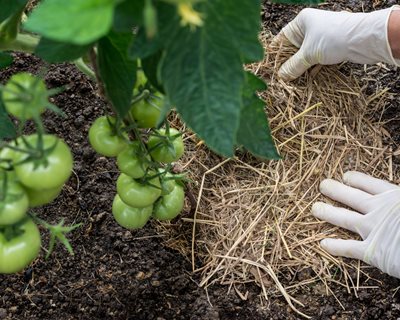
Photo by: Jurga Jot / Shutterstock.
Here are some of the best mulches for different areas of your yard.
- Pathways: Some mulches also make great pathway materials. Gravel or crushed stone are more permanent materials for pathways and are permeable to allow water to percolate into the ground. Organic pathway materials include wood chips or shredded bark. They are permeable and allow for steady footing, even in wet weather. Organic materials may need replenishing every 1-2 years.
- Vegetable plots: Edible crops grow quickly and need lots of nutrients and water to thrive. Straw is one of the most commonly used mulches for edible crops, helping to suppress weeds and retain moisture while keeping fruits clean and off the ground. Nutrient-rich mulches such as compost and grass clippings will retain moisture and quickly break down to nourish plants. Wood-based mulches are effective around perennial crops such as berry bushes and fruit trees. Plastic can be used around warm season crops such as tomatoes, peppers and eggplant to warm the soil more quickly.
- Around acid-loving plants: Wood-based products are acidic, which may affect soil pH in varying degrees. The best mulches for acid-loving plants include pine needles, shredded bark, and wood chips. Plants that thrive in acidic soil include azalea, blueberry, crabapple, dogwood, hydrangea, juniper, rhododendron, and viburnum.
CLIMATE CONSIDERATIONS WHEN CHOOSING MULCH
The effectiveness of mulch may vary in different climates. Dark stone absorbs heat and may harm plant roots in hotter climates. Lighter colored materials that are reflective would be a better choice. Plants that grow in desert regions have different mulching needs than those in rainy climates.
ENVIRONMENTAL CONSIDERATIONS WHEN CHOOSING MULCH
When choosing mulch, consider these environmentally friendly tips:
- Use locally sourced mulch materials, which are are more sustainable than those transported over a longer distance.
- Wood chips can be obtained through local arborists for little or no cost.
- Take advantage of mulch materials that are available in your own yard such as pine needles, leaves, grass clippings, and homemade compost.
- Look for organic mulch products that don’t contain pesticides or other chemicals that may be harmful to soil, wildlife, or pets.
- Avoid or minimize the use of synthetic mulch such as plastic, recycled rubber, and landscape fabric, which do not contribute to soil health and can persist in the environment for many years, impacting soil quality.
FREQUENTLY ASKED QUESTIONS
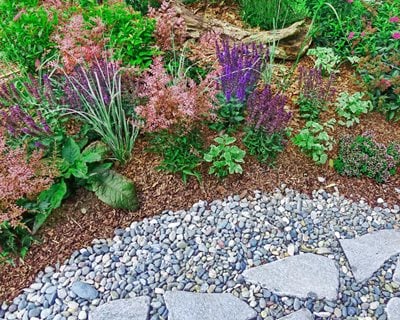
Photo by: AVN Photo Lab / Shutterstock.
Which type of mulch is best?
Mulches have a variety of uses, depending on the type. Before purchasing and applying any mulch, determine what you want to use it for and research the best type for that purpose.
Which mulch lasts longest?
Inorganic mulches such as stone and gravel will last the longest, as they will not decompose. Organic mulch such as wood chips will last longer than compost or shredded bark, as larger chunks take longer to break down.
Does wood mulch attract termites?
Termites gravitate to dark, moist places. If you live in a termite-prone area, use an aromatic wood mulch such as cedar, cypress, or eucalyptus that repels pests. Avoid products made from fir or pine bark. Keep wood mulch 6 to 12 inches away from building foundations and apply in a thin layer that allows it to dry out more quickly. Rake mulch periodically to aerate and allow retained moisture to evaporate. Check mulch regularly for any signs of pests.
RELATED:
How Much Mulch Do I Need?
How & When to Mulch Your Garden
Low-Maintenance Gardening Tips
How to Make Your Own Compost
